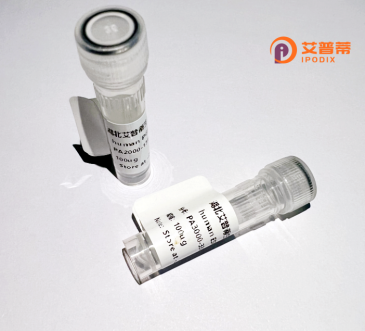
| 纯度 | >90%SDS-PAGE. |
| 种属 | Human |
| 靶点 | GNE |
| Uniprot No | Q9Y223 |
| 内毒素 | < 0.01EU/μg |
| 表达宿主 | E.coli |
| 表达区间 | 1-722aa |
| 氨基酸序列 | MEKNGNNRKLRVCVATCNRADYSKLAPIMFGIKTEPEFFELDVVVLGSHLIDDYGNTYRMIEQDDFDINTRLHTIVRGEDEAAMVESVGLALVKLPDVLNRLKPDIMIVHGDRFDALALATSAALMNIRILHIEGGEVSGTIDDSIRHAITKLAHYHVCCTRSAEQHLISMCEDHDRILLAGCPSYDKLLSAKNKDYMSIIRMWLGDDVKSKDYIVALQHPVTTDIKHSIKMFELTLDALISFNKRTLVLFPNIDAGSKEMVRVMRKKGIEHHPNFRAVKHVPFDQFIQLVAHAGCMIGNSSCGVREVGAFGTPVINLGTRQIGRETGENVLHVRDADTQDKILQALHLQFGKQYPCSKIYGDGNAVPRILKFLKSIDLQEPLQKKFCFPPVKENISQDIDHILETLSALAVDLGGTNLRVAIVSMKGEIVKKYTQFNPKTYEERINLILQMCVEAAAEAVKLNCRILGVGISTGGRVNPREGIVLHSTKLIQEWNSVDLRTPLSDTLHLPVWVDNDGNCAALAERKFGQGKGLENFVTLITGTGIGGGIIHQHELIHGSSFCAAELGHLVVSLDGPDCSCGSHGCIEAYASGMALQREAKKLHDEDLLLVEGMSVPKDEAVGALHLIQAAKLGNAKAQSILRTAGTALGLGVVNILHTMNPSLVILSGVLASHYIHIVKDVIRQQALSSVQDVDVVVSDLVDPALLGAASMVLDYTTRRIY |
| 分子量 | 86.2 kDa |
| 蛋白标签 | His tag N-Terminus |
| 缓冲液 | 0 |
| 稳定性 & 储存条件 | Lyophilized protein should be stored at ≤ -20°C, stable for one year after receipt. Reconstituted protein solution can be stored at 2-8°C for 2-7 days. Aliquots of reconstituted samples are stable at ≤ -20°C for 3 months. |
| 复溶 | Always centrifuge tubes before opening.Do not mix by vortex or pipetting. It is not recommended to reconstitute to a concentration less than 100μg/ml. Dissolve the lyophilized protein in distilled water. Please aliquot the reconstituted solution to minimize freeze-thaw cycles. |
以下是关于重组人GNE蛋白的3篇示例参考文献(注:以下内容为示例,实际文献需通过学术数据库核实):
---
1. **文献名称**: *Expression and purification of recombinant human GNE protein in E. coli for functional studies*
**作者**: Kakani S. et al. (2015)
**摘要**: 本研究报道了在大肠杆菌系统中高效表达人源GNE蛋白的优化方法,通过融合标签进行亲和层析纯化,并获得高纯度蛋白。研究验证了重组蛋白的双功能酶活性(差向异构酶和激酶活性),为后续疾病相关突变体的功能分析奠定基础。
2. **文献名称**: *GNE mutations disrupt sialic acid biosynthesis and contribute to hereditary inclusion body myopathy*
**作者**: Huizing M. et al. (2017)
**摘要**: 文章通过构建重组GNE蛋白的致病突变体(如V572L和D176V),发现突变导致酶活性和唾液酸合成能力显著降低。研究揭示了GNE功能缺陷与遗传性包涵体肌病(HIBM)发病机制的关联。
3. **文献名称**: *Structural characterization of recombinant human GNE using cryo-EM*
**作者**: Chen J.Y. et al. (2020)
**摘要**: 利用冷冻电镜技术解析了重组人GNE蛋白的高分辨率三维结构,揭示了其双功能结构域的空间构象及底物结合位点。研究为针对GNE的药物设计提供了结构生物学基础。
---
**建议**:如需真实文献,可通过PubMed或Google Scholar搜索关键词 "recombinant human GNE protein"、"GNE sialic acid" 或 "GNE HIBM" 获取近年研究。
Recombinant human GNE protein (glucosamine (UDP-N-acetyl)-2-epimerase/N-acetylmannosamine kinase) is a bifunctional enzyme critical for sialic acid biosynthesis, a process essential for cellular glycosylation and cell-surface interactions. GNE catalyzes the first two rate-limiting steps: the epimerization of UDP-N-acetylglucosamine to N-acetylmannosamine (ManNAc) and its subsequent phosphorylation to ManNAc-6-phosphate. Dysregulation or mutations in the GNE gene are linked to hereditary inclusion body myopathy (HIBM), a rare neuromuscular disorder characterized by progressive muscle weakness. The recombinant form of GNE is produced using biotechnological platforms (e.g., bacterial, mammalian, or insect cell systems) to enable functional studies and therapeutic exploration. Research focuses on its enzymatic activity, substrate interactions, and potential as a therapeutic target or supplement for GNE-related myopathies. Challenges include maintaining protein stability, post-translational modifications, and scalability for clinical use. Recent advances in structural biology have resolved its domain architecture, aiding drug design. Recombinant GNE also serves as a tool to investigate sialic acid metabolism's role in immune modulation, cancer progression, and pathogen-host interactions. Ongoing studies aim to optimize delivery methods (e.g., gene therapy, enzyme replacement) to address tissue-specific deficits in neuromuscular diseases.
×